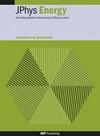纤维素光催化转化为C5低聚糖
IF 6.3
3区 材料科学
Q1 ENERGY & FUELS
引用次数: 0
摘要
纤维素是由葡萄糖单体的线性聚合物组成的,它可能是有价值的化学品和可持续液体燃料的重要来源。然而,纤维素非常稳定,将其转化为有用的燃料或平台化学产品仍然是一个重大挑战(Kimura et al . 2015 Sci。众议员5 16266;夏等,2016 .自然科学学报,7(11162)。光催化是一项用途广泛的技术,已显示出在太阳能驱动的过程,如水分解或太阳能燃料生产方面的潜力,并已应用于空气和水中污染物的降解以及从生物质中生产有用的产品。在这里,我们关注的是由纤维素(葡萄糖(C6)基聚合物)光催化生产的产品,它补充了氢的生产。通过uv - tio2光催化探测初始步骤,我们显著地发现最初产生了一组仅含有5个(C5)碳单元的低聚糖。随着这一过程的继续,C6寡糖逐渐占据主导地位。光催化过程通常不被视为可控的合成过程;然而,这些发现表明,相反,半导体表面的光催化可以实现新的反应途径,产生新的产品。本文章由计算机程序翻译,如有差异,请以英文原文为准。
Photocatalytic conversion of cellulose into C5 oligosaccharides
Abstract Cellulose is made up of linear polymers of glucose monomers that could be a crucial source for valuable chemicals and sustainable liquid fuels. Cellulose is however, very stable and its conversion to a useful fuel or platform chemical products remains a significant challenge (Kimura et al 2015 Sci. Rep. 5 16266; Xia et al 2016 Nat. Commun. 7 11162). Photocatalysis is a versatile technology which has demonstrated potential for solar driven processes such as water splitting or solar fuels production and has also been applied to the degradation of pollutants in air and water and for the production of useful products from biomass. Here, we focus on the products that are produced from cellulose (a glucose (C6) based polymer) photocatalysis that compliment hydrogen production. Probing the initial steps via UV-TiO 2 photocatalysis, we remarkably find that an array of oligosaccharides containing only five (C5) carbon units is initially produced. As the process continues, C6 oligo oligosaccharides grow to dominate. The photocatalytic process is generally not viewed as a controllable synthetic process; however, these findings show, on the contrary that photocatalysis at semiconductor surfaces can achieve novel reaction pathways yielding new products.
求助全文
通过发布文献求助,成功后即可免费获取论文全文。
去求助
来源期刊

Journal of Physics-Energy
Multiple-
CiteScore
10.90
自引率
1.40%
发文量
58
期刊介绍:
The Journal of Physics-Energy is an interdisciplinary and fully open-access publication dedicated to setting the agenda for the identification and dissemination of the most exciting and significant advancements in all realms of energy-related research. Committed to the principles of open science, JPhys Energy is designed to maximize the exchange of knowledge between both established and emerging communities, thereby fostering a collaborative and inclusive environment for the advancement of energy research.
 求助内容:
求助内容: 应助结果提醒方式:
应助结果提醒方式:


